Even during the 1980s and 90s, when Colombia was only known for internal strife, visitors came from all over to see Cartagena, which tells you all you need to know about the appeal this famous destination possesses. Even today, as Colombia’s doors are firmly open to visitors, the well-peopled cobblestone streets and fortresses of bustling Cartagena still exude their 16th-century authenticity and charm.
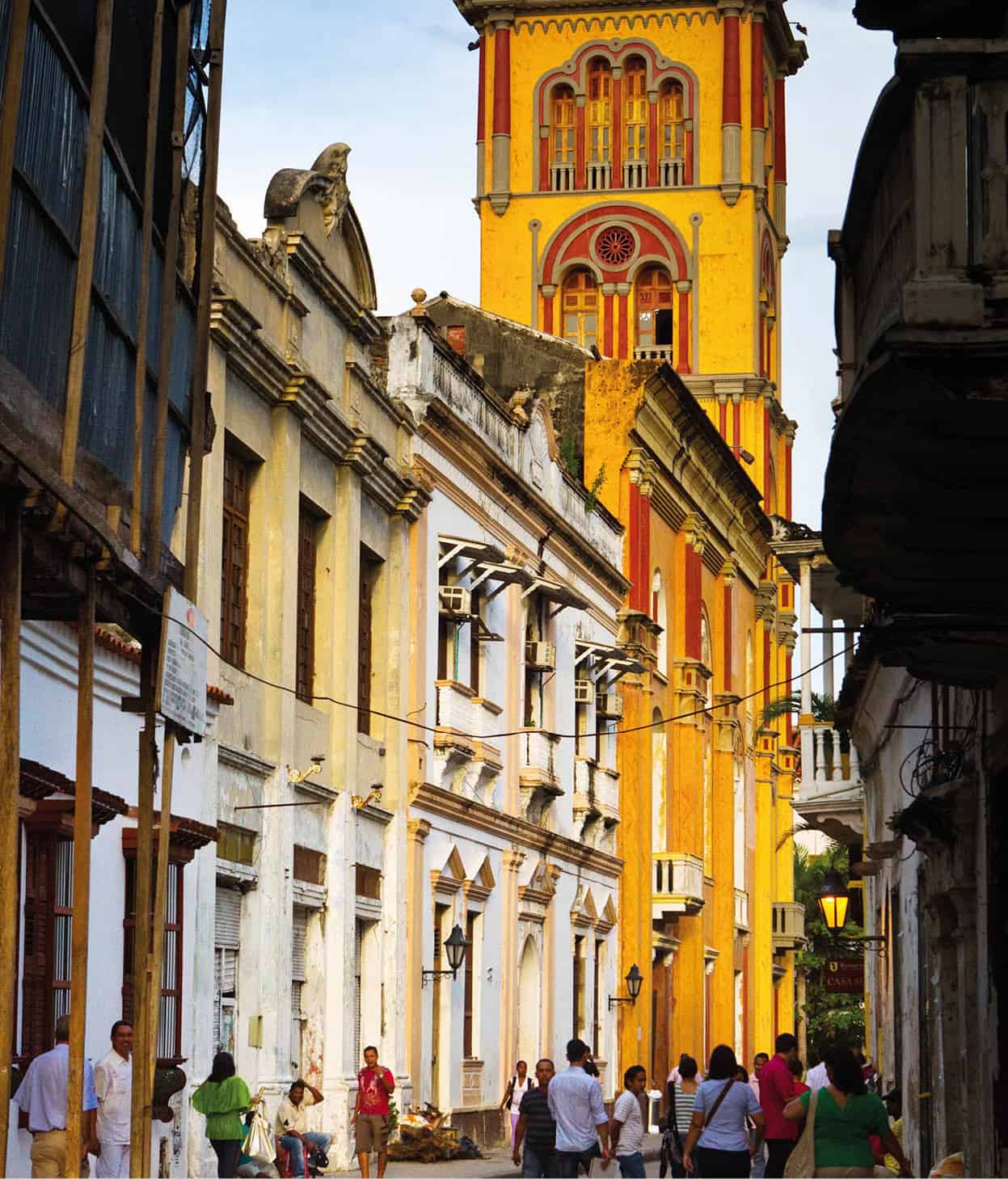
Cartagena’s old city.
Getty Images
Cartagena is located on Colombia’s central Caribbean Coast, where all Costeño people and traditions converge, forming one unique culture that is both homogenous and eclectic. The cuisine – the shellfish, the ceviches, the fish, and the sancochos – represents this eclectic mix of flavors and styles, as does the music.
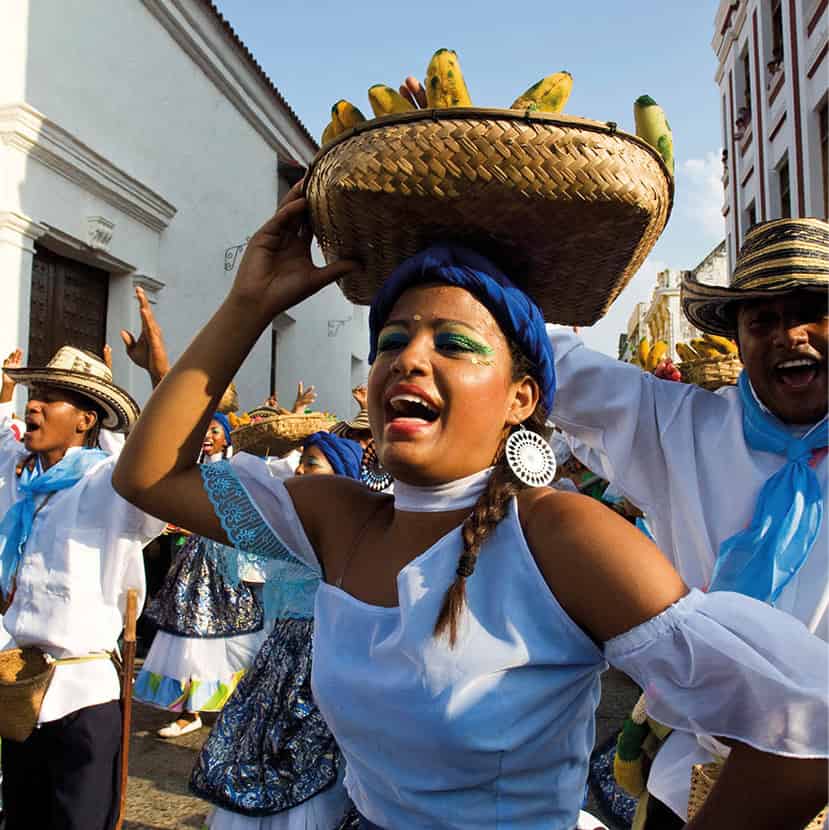
Dancers at the Independence festivities.
Getty Images
This well-preserved ancient hub is also one where the old and the new converge. Many visitors head straight to the walled city, where the cobblestone streets and palm-filled plazas are as romantic and indelible as anything from Márquez’s Love in the Time of Cholera. Modernity does encroach at Bocagrande, where new condominiums, high-rise hotels, and apartments dominate the skyline. Don’t forget the upscale stores and restaurants of San Diego. This diversity of people, culture, and experience is just one reason why Cartagena is a Unesco World Heritage Site and a heavyweight-sized travel destination to this day.
A historical overview
As famous as the first Spanish explorers have become over the millennia, they were often found lacking when it came to navigation. Cartagena’s full name is Cartagena de Indias as the earliest explorers thought they had found the Far East. Pedro de Heredia founded Cartagena in 1533, and it was built on an island just offshore, with marshes separating the city from the mainland.
Cartagena’s position at the mouth of the Río Magdalena meant that it was the perfect trans-shipment point for merchandise coming from Spain and gold shipped back to the old world. For a while the Spaniards assumed they were safe from attacks as the city was built on the Bahía de Cartagena, a bay 15km (10 miles) long and 5km (3 miles) wide, dotted with small islands just offshore. However, these natural sea defenses didn’t deter a number of attackers, including Sir Francis Drake, who briefly controlled the city in 1586.
Once the Spanish got their city back, they resolved to fortify Cartagena in order to protect their gold from future attacks. This is when the ramparts, which have become such an iconic part of Cartagena’s identity, were first built. Forts were built as well, including three on the Puente Román, located in the southeast, which connects the old city with Isla Manga. Fortifications were also built on the mainland and in areas like Bocagrande, Tierrabomba, and Barú. The most muscular and dominating of the fortresses is Castillo San Felipe de Barajas, located across from the Puente Heredia on San Lázaro Hill (see box). The others are San Sebastían del Pastelillo, which was built in the mid-16th century, and San Lorenzo. Fort La Tenaza protected the northernmost point of the walled city, which was vulnerable to attacks from the open sea.
Tip
Cartagena is hot all year round. That said, try to avoid August–November, which are the hottest and wettest months respectively.
The new fortress city seemed impenetrable, so the Spanish turned their sights toward integration. In 1650 they built the Canal del Dique, a 140km (87-mile) -long waterway connecting the Río Magdalena to the city, providing access for ships from upriver ports. Cartagena repelled more attacks, this time from the French. The city prospered in the 18th century, becoming a principal hub in the Viceroyalty of New Grenada. More attacks came, and the Spaniards built an underwater wall to block Bocagrande, thus cutting off one of only two sea entrances to Cartagena.
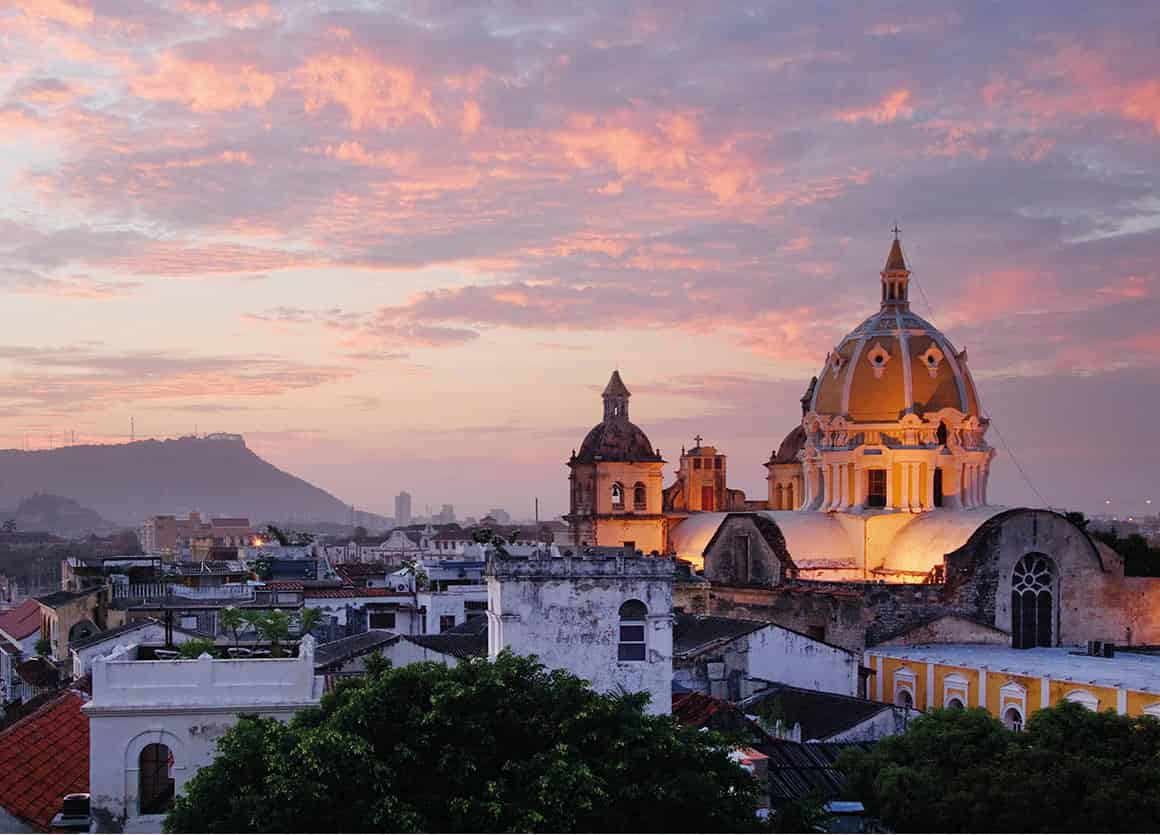
Iglesia de San Pedro Claver.
SuperStock
Fact
The Castillo San Felipe de Barajas (daily 8am–6pm) overlooks Getsemaní and the walled city from San Lázaro Hill just across the Puente Heredia. It has the distinction of being the largest Spanish fort built in the Americas and you’ll find that its imposing presence is a testament to that. Within the structure, there is a network of tunnels, which visitors are free to explore. Good footwear and a flashlight are advisable.
The 12-meter-high walls encircling the old city were completed in 1735. Besides the height, the Spanish focused on density, making them 17 meters (56ft) thick and containing six gates. As with most historical fortifying walls, these were built to keep people in as much as they were to keep people out. The walls acted as a dividing line in the old city, with the lower economic classes living in the outer city, typically in Getsemaní, where you can still find colonial buildings today. The nobility, aristocrats, and high officials lived within the walls, in El Centro, with access to the lush plazas.
Cartagena declared independence from Spain in 1811. The city was a strategic strongpoint to a military genius like Bolívar, and when he arrived a year later he used Cartagena as a base for his campaign to secure the Magdalena region. After being retaken by the Spanish in 1815, patriotic forces retook the city in 1821, and that was the last time the Spanish held sway over Cartagena de Indias.

Castillo San Felipe de Barajas.
SuperStock
Getting your bearings
Cartagena is divided up into multiple sectors, so it can be confusing to navigate the area upon first arrival. Colonial Cartagena is known as EL Centro, and it sits at the north end of Bahía Cartagena, surrounded by 12km (7 miles) of old ramparts. This is where many of the most idyllic plazas, parks, and upscale boutique hotels can be found. Budget hotels can be found in Getsemaní, which has a more working-class and bohemian feel to it. In this historic district, the streets have names instead of numbers, and they change from block to block.
The official downtown borders Getsemaní and doesn’t go by centro, like many city centers do, but La Matuna. The city then continues for 10km (6 miles) north, south, and east, and traveling these extended routes will lead you around the bay, and to the access points for offshore islands, like Islas Rosario. Most churches in the historic districts of Cartagena typically have a 6:45am mass and a 6pm mass. If you need further assistance, be sure to stop by Cartagena’s main tourist office, which is located in the Casa del Marqués del Premio Real on the Plaza Aduana (tel: 5-660 1583; daily 9am–6pm).
Walking the ramparts
One of the best ways to take in Cartagena is by walking one of its most iconic features: the ramparts that encircle the old city. Typically this route takes 90 minutes, but times vary depending on where you start and how often you stop. The best place to begin is the Baluarte San Francisco Javier A [map], continuing around the Circuit to La India Catalina B [map] and on past the lagoons to the Puente Román. The circuit breaks, but its final section is along the Calle del Arsenal and finishes at the Playa Barahona, which is located by the bay. Sunset and sunrise are great times to go, but there’s something about enjoying a sunset from the ramparts that makes the whole experience as delectable as can be. Feel free to hop down off the walls at any time and experience some of the famous sights detailed in this chapter. Also feel free to lose yourself in the old city’s narrow streets and discover the highlights for yourself. Don’t worry – the fact that every block has a different street name will make getting lost a particularly easy proposition.

Horse-drawn carts and taxis head toward the Naval Museum.
Getty Images
The outer city
A good anchor point for the outer city is the Puente Román C [map], which leads from Manga Island to Getsemaní. Manga is known as a residential area home to the Club de Pesca D [map] (Fuerte San Sebastian del Pastelillo; tel: 5-660 5578; www.clubdepescadecartagena.com), a fishing club located on the ramparts that has a great seafood restaurant (and nicer view). On the island you can also walk to the Casa Román E [map], a 19th-century mansion constructed in the Moorish style and home to Teresa Román Vélez, a local legend and celebrity chef in the country. The house isn’t open to the public, but it makes for some nice photos.
Getsemaní on the northwest end of the bridge and is known as the bohemian area of the city, and is home to Cartagena’s many artisans. Many of the single-story casas bajas (low houses) are being refurbished and renovated while keeping their colonial style. They are hot property at the moment and many have already been turned into boutique hotels, cafés, and restaurants. Many of the budget lodgings are here, which means streets like Calles 25 and Calle del Espiritu Santu (Calle 30) are bustling with travelers most nights. Some notable landmarks include the Iglesia San Roque F [map] (Church of San Roque; Calle del Espiritu Santo and Carrera 10c), a 17th-century hermitage and hospital that was built during a great plague. Right here is the Puente Heridia. Cross it, heading east, and you’ll immediately reach the Plaza San Felipe de Barajas G [map]. To the north of here is the start of the downtown sector, La Matuna, where a selection of mid-range hotels can be found between.
Back in Gesemaní there is another historic house of worship, Iglesia de Santísma Trinidad H [map] (Church of Santísma Trinidad; Carrera 10 at Calle del Guerrero). This Holy Trinity church, located on the Plaza de la Trinidad was completed around 1643. Outside this canary-yellow building is a statue of Pedro Romero, who lived in Cartagena at no. 10 Calle del Guerrero. Romero emerged from his house in 1811 and decried, “Long live liberty!” which became the rallying cry to kick off the revolution. Along Calle 25, toward the entrance to the old city, is the Convento San Francisco I [map], a monastery founded in 1555 but sacked by the French in 1559 before being rebuilt in 1590. It 1610 it became the first seat of the Spanish inquisitors, and it’s on the front courtyard where a determined crowd declared independence from Spain on November 11, 1811. Today it’s mostly a commercial center, but there are some beautiful galleries around the internal courtyard.
Nearby, on Calle 25 is the Iglesia de la Tercera Orden J [map] (Church of the Third Order), a whitewashed colonial church featuring a single steeple with twin bells. Both this church and the Convento San Francisco are just south of the Centro de Convenciones K [map] (Calle 24, no. 81-344; tel: 654 4000), which is Cartagena’s main convention center. Built in 1972, the center seats around 4,000. If there isn’t an event scheduled, see if you can find a guide to show you around. At night, near the arches leading into the walled city, vendors set up stands selling shrimp cocktails (known as ceviche in Colombia, unlike in Peru). There is a month-long Feria Artesania (craft fair) held the in Parque del Centenario L [map] each year, but the month in which it is held changes from year to year. For more details, see www.artesanosdelparquecentenario.blogspot.co.uk.
Walk through the Puerta del Reloj from Getsemaní and you’ll arrive at the Plaza de los Coches M [map].This is one of Cartagena’s most iconic plazas in the old city, but it has a dark past. Originally it was the site of the slave market, but then it became a sort-of transportation hub for embarking carriages. The long galleries here, at the base of the colonial buildings, offer much-needed respite from the sun’s relentless assault. Inside them you’ll find the Portal de los Dulces, a confectionery store selling cookies, dulce de coco (coconut brittle), and much more. There are also a number of fine bars with seating inside as well as patio tables. Sit outside during the day or night and you may well be treated to an impromptu music or dance performance.
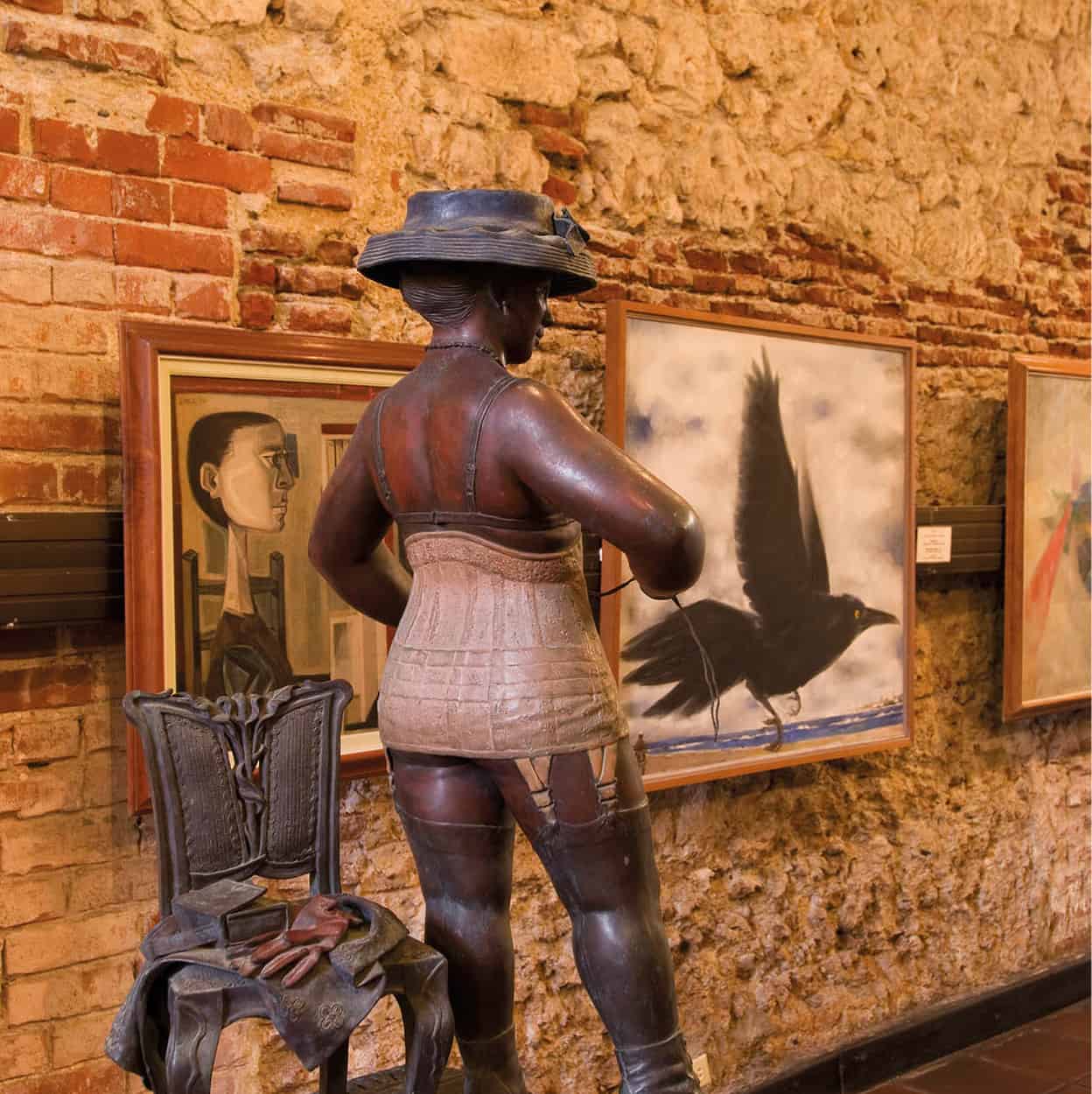
Museum of Modern Art.
Getty Images
Just south and around the corner from Los Coches is the Plaza de la Aduana N [map], which features a large white statue of Christopher Columbus surrounded by flower bushes. Behind the plaza are the Palacio Municipal and the Casa del Marqués del Premio Real, which was the onetime home of the King’s representative from Spain. On the corner is the Museo de Arte Moderno O [map] (Museum of Modern Art; tel: 5-664 5815; www.mamcartagena.org; Mon–Fri 9am–noon, Sun 4pm–9pm; free last Sun of month), a two-story museum focusing mostly on Latin American art from the 1950s onward.
A 17th-century Jesuit church and monastery, the San Pedro Claver (Mon–Fri 8am–5.30pm, Sun 8am–5pm) is located near the museum at Plaza San Pedro. It is named after a local monk, Peter Claver, who was known as El Apóstol de los Negros (The Apostle of the Blacks) as he lent his lifelong energies to the neglected and the oppressed, and supported the liberation of slaves. Often he would go door-to-door begging and give the money he received to the African slaves traded in Cartagena. Claver died in 1654 and was canonized in 1896 by Pope Leo XVIII. His body is kept over the altar in a glass coffin. Upstairs rooms form a museum featuring items used by Claver, including maps and furniture.
The Baluarte San Francisco Javier, a fortification at the southwest end of the old city, is worth a visit even if you aren’t into climbing up old walls. This is probably the best place for a relaxing sunset drink in all of Cartagena, so pull up a patio table there at Bar el Baluarte P [map] (www.baluartesfj.com) and wash away the day’s heat with a luxury cocktail. Nearby, at the Plaza Santa Maria Q [map] is the Museo Naval del Caribe (Calle San Juan de Dios, no. 3–62; tel: 5-664 9672; www.museonavaldelcaribe.com; daily 8am–5pm), which features old nautical maps from the colonial era, armaments, indigenous artifacts, and much more.
Also nearby, at the corner of Calle Ricaurte, is the old Convento Santa Teresa, a convent founded in 1609 for Carmelite nuns. The building has had many uses since, acting as a prison, a school, a barracks, and, in the 1970s, a police headquarters. The Banco Central purchased the building and it has since been turned into the Charleston Santa Teresa Hotel. Non-guests are allowed to enter the hotel’s public areas.
Other sites worth visiting in the old city include El Bodegón de la Candelaria R [map] (Calle Las Dama, no. 3–64), a restored colonial house that’s over 300 years old, with white balconies and yellow walls. Supposedly a priest who lived in the home during its earliest days saw an image of the Virgin Mary, and there’s a shrine in the room where the vision occurred. The green and leafy Plaza de Bolívar S [map] is located one block away and features an equestrian statue of the Liberator. As you’ve surely gathered by now, you won’t find a Simón Bolívar statue anywhere in Colombia that doesn’t exude valor and stateliness. Impromptu shows often occur here, and if you’re lucky you may see some cumbia dancers moving to the rhythms from the Palenque region just south of Cartagena.
On the west side of the plaza is the Palacio de la Inquisición (Mon–Fri 9am–6pm), the premises where the Inquisition set up shop. The tribunal’s jurisdiction included all of New Grenada, including Venezuela, Panama, and Nicaragua. The current building dates from 1706 and, all told some 800 people were sentenced to death on this site for ‘Crimes against the Christian Faith.’ It operated until revolution broke out in 1811, and was eradicated altogether when the new country was formed in 1821. The well-preserved stone door is the most ominous thing about the exterior of the museum, and the rest is a rather pleasant example of colonial Baroque complete with whitewashed walls and wooden balconies. However, the various torture and execution implements on display inside serve as a reminder of the building’s violent past.
Tip
Colonial homes aren’t known for their density, so expect the walls in most colonial accommodations options in the walled city to be on the thinner side. The exceptions are the most luxurious of refurbished hotels.
Opposite the Inquisition museum is the Museo del Oro Zenú (Tue–Sat 9am–5pm, Sun 10am–3pm; free), another satellite branch of the national Museo del Oro, this one featuring pre-Columbian gold artifacts and pottery from the nearby Zenú indigenous region, which is located south of Cartagena at the marshlands of the Sinú, Magdalena, and San Jorge rivers. From the 2nd to the 10th century, these areas enjoyed the densest population of indigenous, and many of the artifacts on display are from this time period. At the northwest corner of the park is the Catedral de Cartagena. This church has been through a lot: it was completed in 1612 after being nearly destroyed by Sir Francis Drake. It was renovated twice in the 20th century and is fairly humble by Colombian colonial church standards, although the interior features a marble pulpit and gilded altar.
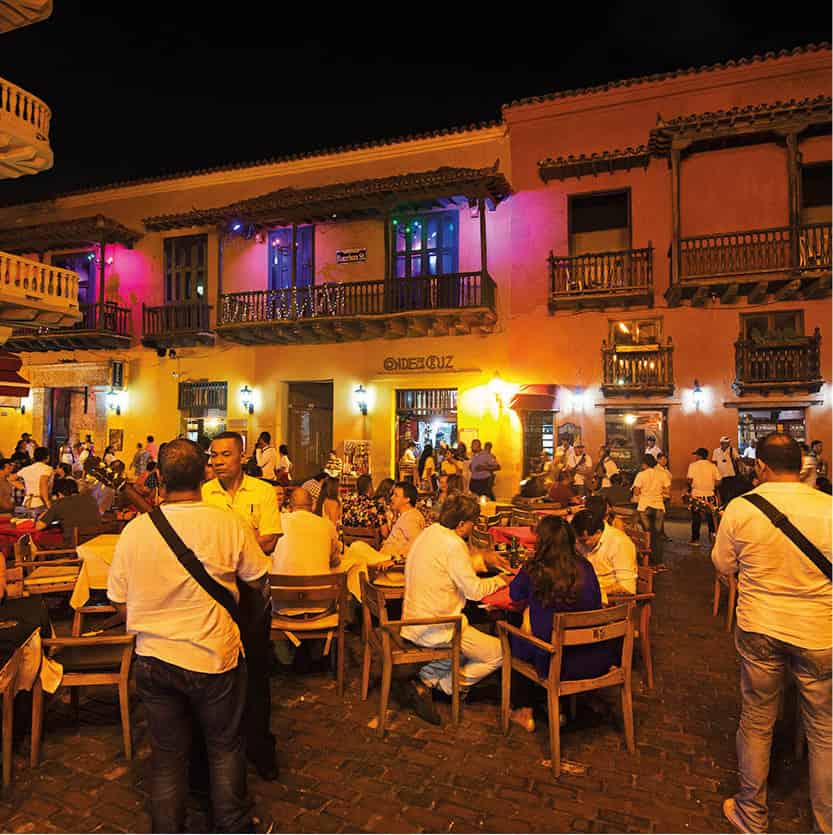
Alfresco dining, Plaza de Santo Domingo.
Getty Images
Across the street from the plaza is the long, white Palacio de la Proclamación T [map], which is named after the proclamation of the declaration of independence and was once a governor’s residence. Nearby is the Convento Santo Domingo U [map], regarded in some circles as the oldest church in Cartagena, with constructing beginning around 1551. The present monastery replaced the old one in the 17th century, and today the outside of the church is beginning to look its age. Inside the church, behind a Baroque 19th-century altar, there is a 16th-century carving of Christ. Adjacent to the church is the Plaza Santo Domingo, which might just be the busiest section of the old city. There is no shortage of places to eat and drink here. The Botero sculpture on the plaza, La Gorda, is a delightfully corpulent alternative to the colonial surroundings.
North of Santo Domingo is the Casa del Marqués de Valdehoyos V [map] (Calle de la Factoría, no. 36–47), a picture-perfect mansion that was once home to the Marquess of Valdehoyos, a slave-holding sugar magnate. Inside is great woodworking, from the chandeliers to the balustrades. Northeast of here you’ll find Plaza Merced, which is bordered by a church and convent of the same name. The church was founded in 1618, and is now the Teatro Heredia, an opulent concert hall. Walk east two blocks and you’ll arrive at Calle de la Universidad, at the end of which is the Monastery San Augustín W [map], which was completed in 1580 but has been the home of the Universidad de Cartagena since 1828.
Walk along Baudillo (Carrera 7) and you’ll arrive at the Iglesia Santo Toribio de Mogrovejo. It has a Baroque altar and, interestingly, you can still see the damage caused by a cannonball that went through the church in 1741 and lodged in the west wall. Last but not least, book lovers will want to visit the Casa de Gabriel García Márquez X [map] (located behind the Santa Clara Hotel), on the corner of Calle del Curato. This was the Cartagena home of Colombia’s favorite son, and it only makes sense that the born Costeño made his home in the historic heart of the Colombian coast.
Fact
East from the walled city, 150 meters up at Cerro La Popa, is the Convento La Popa (daily 8.30am–5.30pm). It was founded in 1607 by the Augustine Order of Fathers. In the complex, you’ll have access to the Augustine church as well as the restored convent. You can arrange for a tour up the hill through a hotel or hostel, or pay a taxi driver around US$12–15 to take you up and back.
No matter where you stroll in Cartagena’s historic districts, you won’t be found wanting for restaurants. Even so, the San Diego quarter, located in the north of the walled city, is known for its large and varied selection of truly quality eateries. Ground zero for exploring this area is the intimate Plaza Fernández de Madrid, with its statue of the statesman, scientist, and former president of New Grenada in the early 1800s. There are good restaurants around the plaza, but head north and you’ll find some real gems.
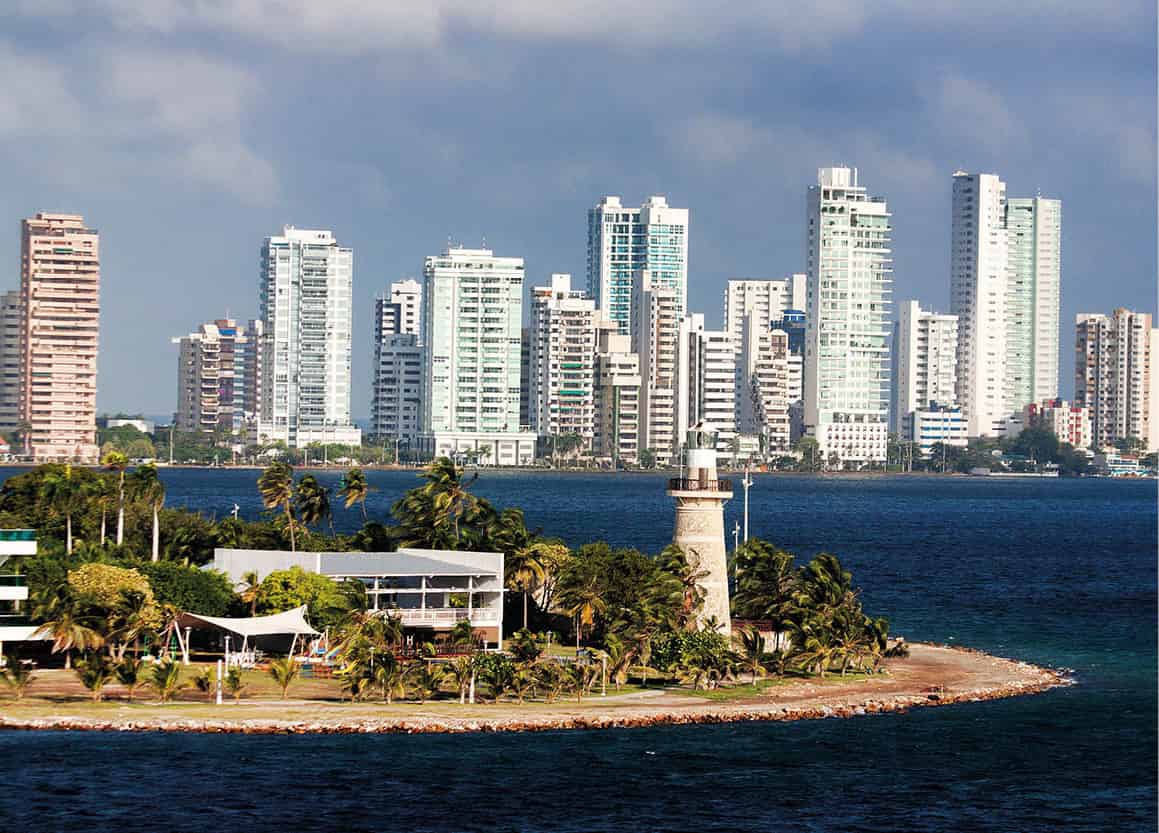
View towards Bocagrande.
iStock
Bocagrande
Bocagrande is where colonial Cartagena ends and the modern metropolis takes over. The area is less than one kilometer (just over half a mile) from the walled city, yet it feels a million miles away. This southern part of Cartagena is unmissable: shimmering apartment buildings, hotels, and condominiums jut into the sky, and tower cranes are ever at work erecting new homes for Colombia’s privileged elite. Locals come here for the beach, but, as with most beaches flanking the city, the water is nothing to write home about. However, it does get better farther south, toward the Hilton. On the southern tip of the area is the Fuerte Castillo Grande, which was built to protect Cartagena’s inner harbor. To get to Bocagrande take a bus heading south from the entrance to the walled city, the Puerto del Reloj.
Marbella and the north
Marbella Y [map] is a beach used mainly by locals, roughly one kilometer north of the walled city, past Plaza Las Bovédas, which is a structure dating to 1799 with 12-meter high walls. At the base of it are a number of stores that used to be dungeons. During the week Marbella Beach is quieter than Bocagrande, although it often isn’t great for swimming due to strong currents. Just beyond, the promontory is lined with new high-rise hotels with private beach access.
Beyond that is the route to Playa Manzanillo, a remote beach about 10km (6 miles) from Cartagena, located in the tiny town of Manzanillo. This is a great place to come get away from the city and have whole stretches of coastline to yourself.
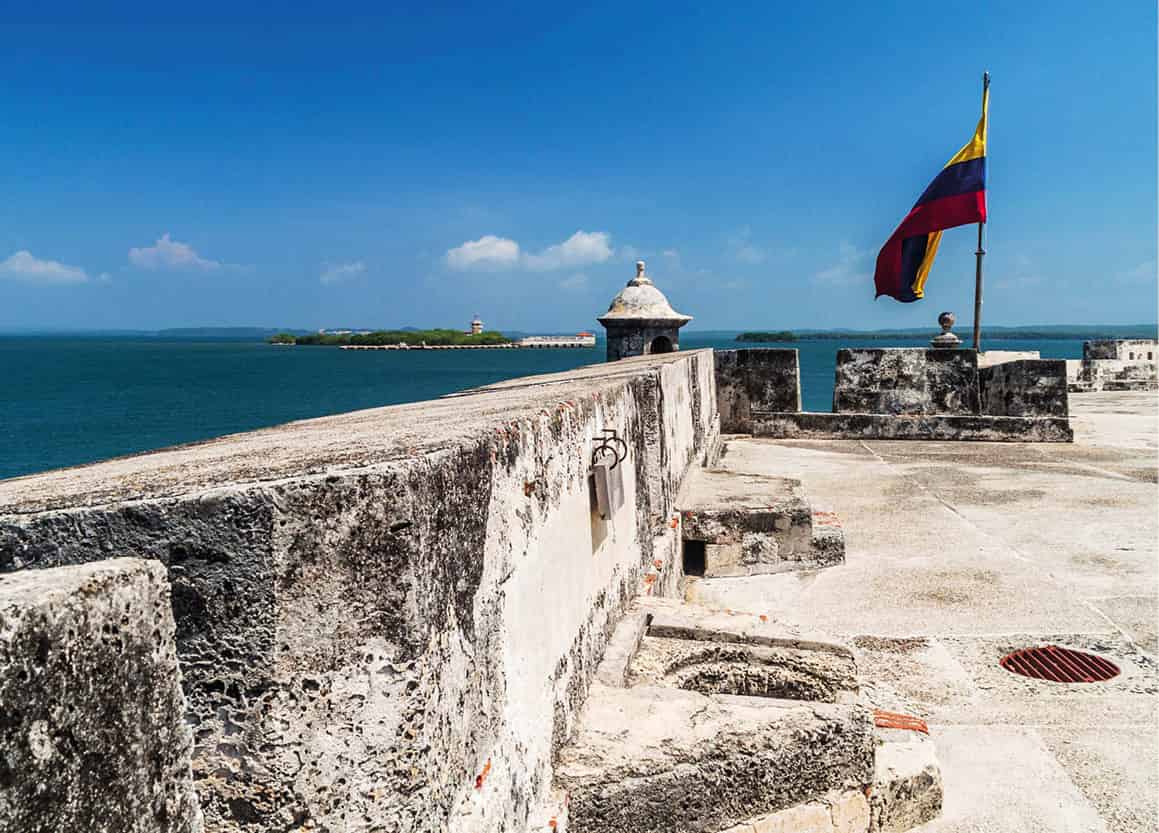
Fuerte de San Fernando on Tierrabomba Island.
Shutterstock
Isla de Tierrabomba
In the south, between Bocagrande and Barú Island is Tierrabomba, an island that acts as a natural barrier between Cartagena and the open sea. Fuerte San Fernando overlooks the bay from the southern tip of the island, and nearby Isla de Barú has the Fuerte San José. At one time these two forts were connected by chains in order to dissuade pirate attacks. Bocachica Beach is the main strip of sand here, but the water isn’t the cleanest. Boats leave for Tierrabomba from the muelle turistico (tourist pier) Z [map].
Tip
Various companies at the tourist dock in Cartagena sell transportation tickets that vary in price. However, you should be paying around US$20 for tickets to Islas del Rosario and Playa Blanca. Be aware that there is also a port tax of US$6.
Isla de Barú
When tourists and locals want a quick escape to typically beautiful Caribbean beaches, they come to Isla de Barú. It is the closest island to Cartagena, and one that is linked via road as well as by waterways. The tourist boats stop at Playa Blanca, the most famous beach in the area. Its pristine white sands and crystalline waters are the reasons people come here. There are some fish restaurants here, the most notable of which is Gabriel (open daily). Take caution when swimming, as some have reported careless jet-skiers speeding too close to shore and frightening the bathers. There are some lodging options here as well as hammock rentals and camping. If you come in the morning you’ll find the beach can be quite crowded, but it calms down once the last arrival boats have left in the early afternoon.

Isla de Barú.
Getty Images
To arrive at Playa Blanca by car, you can take a shared taxi for US$7 per person. Alternatively, take a bus from Cartagena’s center to Pasacaballo and then a ferry across the Canal del Dique (the waterway separating Barú from Cartagena). Faster boats depart from the Mercado Bazurto between 7am–9.30am daily.
To the far southwest is an archipelago of some 30 islands that fall under the purview of Cartagena. These also make up the Parque Nacional Natural Corales del Rosario y San Bernardo. These coral islands are located 45-minutes from the Bay of Cartagena and are characterized by low-lying and densely vegetated terrain with the occasional narrow stretch of sand peaking out from the water. This is another of Cartagena’s star beach getaways, and many head straight for Isla Grande, the biggest and most protected of the islands, with plenty of avian and aquatic life on display. There are also a number of islets that make for excellent snorkeling. Day tours to the island leave from la Bodeguita tourist pier in Cartagena between 7am–9am and return at 4–5pm. The tours include round trip tickets and lunch on the island.
